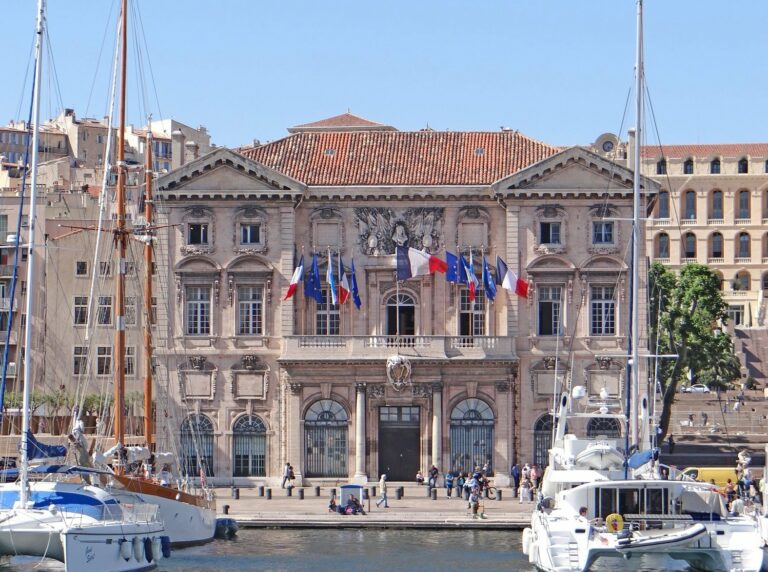What are some unique local foods to try in Marseille that may not be found in other parts of France?
When in Marseille, be sure to sample some of the delicious French local foods that are unique to the region. Bouillabaisse, a traditional fish stew, and panisse, a chickpea flour fritter, are must-tries. Also, don’t miss out on trying pieds et paquets, a dish made of lamb offal and trotters.
Bouillabaisse
Bouillabaisse stands out as a celebrated seafood stew with its roots deeply planted in Marseille’s dynamic culinary scene. This exquisite stew mirrors the city’s gastronomic history and its symbiotic bond with the Mediterranean. The preparation of bouillabaisse is unique due to its slow-cooking process. It typically includes a medley of fresh fish such as red mullet, monkfish, and sea bass, plus shellfish like mussels and crab. These are gently stewed in a rich broth flavored with tomatoes, onions, garlic, the distinct notes of saffron, and a blend of aromatic herbs. The outcome is a rich and aromatic soup that encapsulates the essence of maritime flavors. For those seeking the quintessential taste of bouillabaisse in Marseille, Chez Fonfon stands out. Nestled in the scenic Vallon des Auffes, this eatery is renowned for its dedication to crafting bouillabaisse with precision and passion. Another esteemed venue is Restaurant Miramar, a cornerstone in Marseille’s culinary landscape since 1935, celebrated for its flavorful bouillabaisse with ample servings of fish. Diners eager to savor authentic bouillabaisse will find these restaurants at the pinnacle of their search. Their commitment to classic cooking methods and insistence on the freshest ingredients guarantees a bouillabaisse experience that’s both genuine and unforgettable.Socca
Socca, a cherished delicacy of Marseille, epitomizes the rich culinary culture of this French city. This chickpea-based pancake is gluten-free, combining health consciousness with a satisfying flavor profile. Its preparation involves a straightforward mix of chickpea flour, water, olive oil, and salt. The mixture is then baked at high temperatures to achieve a crisp exterior and a soft interior. When visiting Marseille, sampling socca is essential. Chez Sauveur, nestled within the bustling Vieux Port, offers an exemplary version of this dish. Their socca emerges from the oven with a desirable balance of a lightly burnt crust and a creamy core, infused with the subtle nuttiness of chickpeas and the savory notes of olive oil. Another notable establishment is Le Four des Navettes, a bakery steeped in history since 1781. Here, socca is prepared in a wood-fired oven, imparting a distinctive smoky taste that complements a refreshing glass of rosé. For anyone interested in gastronomy, trying the socca in Marseille provides an authentic taste of the region’s gastronomic scene. Enjoying this local specialty allows for a deeper appreciation of the area’s traditional flavors.Panisse
In Marseille, my culinary journey led me to a local staple, Panisse, which is a testament to the simplicity and flavor potential of chickpea flour.- Panisse: A Cultural Culinary Pillar:
- Homemade Panisse: A Step-by-Step Guide:
- Blend 1 cup chickpea flour, 2 cups water, and a dash of salt in a saucepan.
- Stir until smooth, eradicating any clumps.
- Over medium heat, stir the mixture for roughly 10 minutes or until it thickens noticeably.
- Transfer the thickened blend into a greased dish, leveling it with a spatula.
- Let it rest for a minimum of 2 hours to firm up.
- Slice the firm mixture into squares or strips.
- In a pan, warm some olive oil and pan-fry the pieces until they boast a golden crunch.
- Serve these immediately for a warm, authentic taste of Marseille’s panisse.
Navettes
Navettes, Marseille’s signature pastry, embody the rich culinary traditions of the city. Originating in the 19th century, these unique, boat-shaped biscuits were reputedly first crafted by the nuns at Saint Victor Abbey, inspired by the vessels that transported Saint Lazarus’s relics to Marseille. Crafted from basic components like flour, sugar, eggs, and butter, the dough for navettes is enhanced with the scent of orange blossom water, imparting a distinctive floral fragrance. Each piece is meticulously crafted into a boat form and baked to a perfect golden hue. Biting into a navette fresh out of the oven is a delightful experience. Its exterior offers a gentle crunch, encasing a soft, delicate interior. The orange blossom water infuses a subtle yet lingering floral undertone that enhances the flavor. In Marseille, pairing navettes with tea or coffee is a common practice, especially in the afternoon. These pastries also hold a special place during festive occasions like Candlemas and Easter. For anyone in Marseille, tasting a navette is essential, offering a glimpse into the city’s gastronomic legacy. The simplicity of the recipe and its connection to local history make navettes more than just a treat; they’re a cultural emblem. Their enjoyment isn’t only a matter of taste but also an act of participating in a long-standing Marseillaise tradition.Aïoli
Aïoli, a treasured component of Marseille’s food scene, is a rich sauce teeming with garlic that enhances any meal. Crafted from powerful yet straightforward ingredients, aïoli transforms simple foods into culinary masterpieces. To truly appreciate this divine sauce, consider these insights:- Core components of aïoli:
- Garlic is crucial, infusing the sauce with its robust and aromatic essence.
- Choosing a high-quality olive oil is key to achieving a smooth and opulent texture.
- Egg yolks contribute depth and are vital for the sauce’s smooth and creamy texture.
- Provençal Aïoli: This traditional recipe calls for garlic, olive oil, egg yolks, and a hint of lemon juice.
- Catalan Allioli: This version is a robust garlic mayonnaise made without egg yolks, offering a more intense garlic taste.
- Ligurian Agliata: Similar to the Catalan version, but includes bread soaked in vinegar for a zesty flavor.









